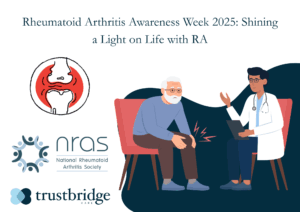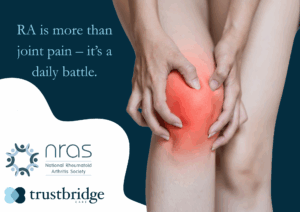
What is RA?
- Rheumatoid Arthritis (RA) is a chronic autoimmune condition in which the immune system mistakenly attacks the lining of the joints (the synovium), leading to inflammation.
- Over time, this inflammation can damage cartilage and bone, stretch ligaments and weaken joints.
- Unlike some other forms of arthritis, RA often affects joints symmetrically (both sides of the body) and can also affect other systems (lungs, skin, eyes) beyond the joints.
Impacts on those diagnosed & their families
Symptoms
- Joint pain, swelling, warmth, tenderness and stiffness — especially in smaller joints (hands, wrists, feet) first. Morning stiffness (lasting more than 30 minutes, often longer in RA) is typical.
- Fatigue, lack of energy, sometimes fever, weight loss, poor appetite.
- Extra‐articular effects: e.g. eye dryness, issues with heart or lungs, rheumatoid nodules under skin.
Disability & daily life
- Difficulties with everyday tasks: gripping, opening jars, turning taps, dressing, walking, stairs. Stiffness and pain can restrict mobility, dexterity.
- Fatigue and pain can disrupt work, social life, sleep, and mental health. Families often share the burden (helping with care, household tasks, emotional support).
Treatments & surgeries
- Medications:
- Disease-modifying antirheumatic drugs (DMARDs) (e.g. methotrexate, sulfasalazine, hydroxychloroquine) which slow disease progression.
- Biologic treatments (targeted immune therapies) used if conventional DMARDs aren’t enough.
- JAK inhibitors (for moderate to severe RA) in certain cases.
- Symptom relief: NSAIDs, painkillers, steroids (often short‐term/across flares)
- Supportive care:
- Physiotherapy, occupational therapy for maintaining movement, flexibility, managing joint use, adapting daily tasks.
- Podiatry if feet are affected. Devices or aids to help with daily living.
- Surgery:
- In more advanced cases, joint replacement (hip, knee etc.), joint reconstruction, tendon repair may be required to restore function, relieve pain, or correct deformity.
- Other procedures might be used to release constricted joints or remove damaged tissue.
Progression of RA
RA doesn’t follow exactly the same path in everyone; it’s highly variable. Some people have aggressive disease, others more slow‐progressing.
- Early phase: symptoms may begin gradually, often subtle (joint stiffness, mild swelling) and tend to be worse in the morning or after inactivity.
- Flares vs remission: periods of worsening symptoms (flares) interspersed with calmer periods. Managing to a low level of disease activity (or remission) is a key goal.
- Over time, if not well managed, inflammation can lead to:
- Cartilage and bone erosion
- Joint deformity
- Loss of function in joints
- Extra‐articular damage (e.g. to lungs, heart)
- Greater disability, reduced quality of life.
- Certain factors tend to be associated with worse progression: late diagnosis, delayed treatment, certain blood markers (e.g. high antibodies like anti‐CCP), lifestyle factors (smoking, obesity), frequency of flares.

Why raising awareness matters
- Misconceptions persist: RA is often thought of simply as “old‐age arthritis” / joint wear and tear (osteoarthritis), but RA is different. It’s autoimmune, systemic and can strike younger people. Awareness helps correct that.
- Early diagnosis and treatment can make a big difference: catching RA early leads to better outcomes, less joint damage, better chance of remission or low disease activity.
- Awareness helps with access to services: patients often need multidisciplinary care, therapy, aids, etc. Without awareness among public & professionals, delays in support can occur.
- Support & mental health: people with RA frequently experience emotional burden, social isolation due to fatigue, pain, loss of function, so raising awareness helps reduce stigma, encourages support from family, employers, community.
- Research, funding, policy: awareness drives public and political will, fundraising, research into causes, treatments, maybe prevention.
How can TrustBridge Care support those living with RA
TrustBridge Care offers personalised home care services designed to help people live independently in their own homes.
Services include:
- Personal care (help with washing, dressing, hygiene) which can assist when joint pain/stiffness make these tasks difficult.
- Live-in care, for people who need more continuous support.
- Assistance with daily tasks (meal prep, medication reminders, mobility support, transfers etc.).
Additional ways TrustBridge Care could support:
- Respite care: giving family carers a break.
- Specialized care plans adapted to RA: understanding daily “flare” periods, adapting schedules (resting, activity), avoiding overexertion.
- Liaising with physiotherapists / occupational therapists to carry out exercises at home, provide advice on aids (rails, walking aids, etc.).
- Emotional and social support: helping clients feel less isolated, facilitating activities they enjoy (adapted), encouraging connections to local peer/support groups.
- Helping with journeys to appointments, ensuring adherence to medication schedules, monitoring for worsening symptoms so that medical attention can be arranged early.
What others can do to raise awareness
- Share stories: people living with RA sharing their experiences (on blogs, social media, video) helps others understand what RA feels like day to day — the “invisible” side (fatigue, pain, what feels like a drained battery). This was a theme in NRAS’s RA Awareness Week 2023 (#RADrain)
- Educational campaigns in workplaces/schools etc: ensure people know the signs, that it’s not just “wear & tear,” that early action helps.
- Promote screening / early detection: encourage GP awareness of RA symptoms; help people know when to seek help.
- Support & fundraise for charities (e.g. NRAS, Versus Arthritis) who provide information, research, advocacy.
- Lobby for better services: provision of physiotherapy / occupational therapy, access to specialist rheumatology care, social care support.
- Use social media: hashtags, awareness graphics; encourage #RAAwareness, etc.
- Encourage healthy lifestyle factors: smoking cessation, maintaining healthy weight, physical activity, diet (anti‐inflammatory effects) as preventive / supporting measures.
https://nras.org.uk/event/ra-awareness-week-2023/
https://www.nhs.uk/conditions/rheumatoid-arthritis/
